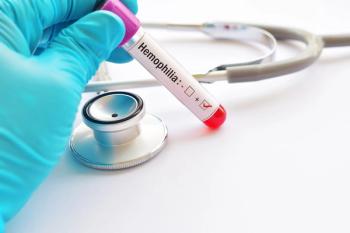
Andrew Alexis, MD, MPH, highlights positive lebrikizumab-lbkz data for atopic dermatitis
Lebrikizumab demonstrated efficacy and safety in patients with skin of color and moderate to severe atopic dermatitis in the ADmirable trial. Trial investigator Andrew Alexis, MD, MPH, reacts.
Recent 24-week data from the ADmirable study reinforce the safety and efficacy of lebrikizumab-lbkz (Ebglyss; Eli Lilly) in adolescents and adults with moderate to severe
Lebrikizumab-lbkz, a biologic targeting IL-13
According to the company, the study included adults and adolescents 12 years or older with a weight of at least 40 kg who identified as Black or African American, Asian, American Indian or Alaska Native, or Native Hawaiian or Other Pacific Islander. All participants had moderate to severe AD and pigmented skin as measured by the Fitzpatrick skin phototype scale.
At week 24, 78% of participants achieved at least a 75% improvement from baseline in the Eczema Area and Severity Index (EASI-75), including more than 88% of those with Fitzpatrick skin types V and VI. Among those who had responded to treatment by week 16, 63% achieved a high bar of deep skin response as measured by at least 90% improvement in their eczema extent and severity (EASI-90), according to Eli Lilly. In addition, 73% of week 16 responders successfully transitioned to a once-monthly maintenance dose.
Improvement in itch symptoms was also observed, with 60% of patients achieving a reduction of 4 points or more on the Peak Pruritus Numerical Rating Scale. Among participants with postinflammatory hyperpigmented lesions at baseline, 64% had visible improvement in hyperpigmentation at 24 weeks based on assessments with the PDCA-Derm scale, a dermatologic evaluation tool used in patients with skin of color.
The safety profile in ADmirable was consistent with previous phase 3 studies of lebrikizumab, and no new safety signals were identified.
Andrew Alexis, MD, MPH, professor of clinical dermatology and vice chair for diversity and inclusion in the Department of Dermatology at Weill Cornell Medicine, dermatologist at New York-Presbyterian/Weill Cornell Medical Center, and lead ADmirable investigator, discussed the implications of these results in the Q&A interview below.
Contemporary Pediatrics: Can you highlight and provide the findings from recent 24-week data of lebrikizumab-lbkz and explain the makeup of the trial and the study population?
Andrew Alexis, MD, MPH: In this analysis presented at RAD, we presented the 24-week efficacy and safety outcomes of lebrikizumab in adult and adolescent patients with moderate to severe AD and skin of color, a historically underrepresented patient population in clinical trials, for which important data gaps and health care disparities exist. The study included innovative measures of postinflammatory pigment alteration associated with AD using a novel scale called PDCA. Lebrikizumab improved AD signs and symptoms (including itch) through 24 weeks of treatment across Fitzpatrick skin phototypes, with continued improvement from weeks 16 to 24.
Of note, postinflammatory hyperpigmentation, assessed through PDCA-Derm, improved in almost two-thirds of patients by week 24.
The favorable safety profile of lebrikizumab was also demonstrated with no new safety signals.
Contemporary Pediatrics: How crucial are these data among a wide-ranging group of patients with varying skin tones?
Alexis: These data support the efficacy and safety of lebrikizumab in patients with skin of color and Fitzpatrick skin phototypes IV to VI. Being able to communicate to patients [with] AD with skin of color that treatment with lebrikizumab can not only improve the signs and symptoms of AD but can also result in improvement in AD-associated postinflammatory pigment changes is extremely impactful and very relevant to this patient population. Sharing these data can help build trust that translates into greater adherence to therapy and improved outcomes for patients with skin of color, who have historically not been well represented in clinical trials.
Contemporary Pediatrics: Since its approval in 2024, what has the reception to this treatment been, and can you speak to the overall treatment landscape for pediatric atopic dermatitis?
Alexis: Lebrikizumab has been a welcome addition to our therapeutic armamentarium. Being able to offer more treatment options including this safe and efficacious IL-13–specific antagonist, the second agent to be approved in this class, has helped opened the door to more individualized care through shared decision-making.
Additional options for our pediatric patient population include the recently FDA-approved targeted topical agents
Contemporary Pediatrics: Is there anything else you would like to include?
Alexis: Overall, this is an exciting time in the field of AD in that we are able to offer our patients so many more treatment options than just a few years ago. The targeted nature of our current treatment options (eg, biologics, JAK inhibitors, phosphodiesterase-4 inhibitors, and an aryl hydrocarbon receptor agonist) has ushered in a new era in the management of AD that is rooted in our improved understanding of the pathomechanisms of this complex disorder.
References
- Alexis A, Moiin A, Waibel J, et al. Efficacy and safety of lebrikizumab in adult and adolescent patients with skin of color and moderate-to-severe atopic dermatitis: final 24-week results from the phase 3b, open-label ADmirable study. Presented at: Revolutionizing Atopic Dermatitis Conference 2025; June 6-7, 2025; Nashville, TN.
- Kunzmann K. FDA approves lebrikizumab for atopic dermatitis in patients 12 years and older. Contemporary Pediatrics. September 13, 2024. Accessed June 25, 2025. https://www.contemporarypediatrics.com/view/fda-approves-lebrikizumab-atopic-dermatitis-patients-12-years-older
Newsletter
Access practical, evidence-based guidance to support better care for our youngest patients. Join our email list for the latest clinical updates.










